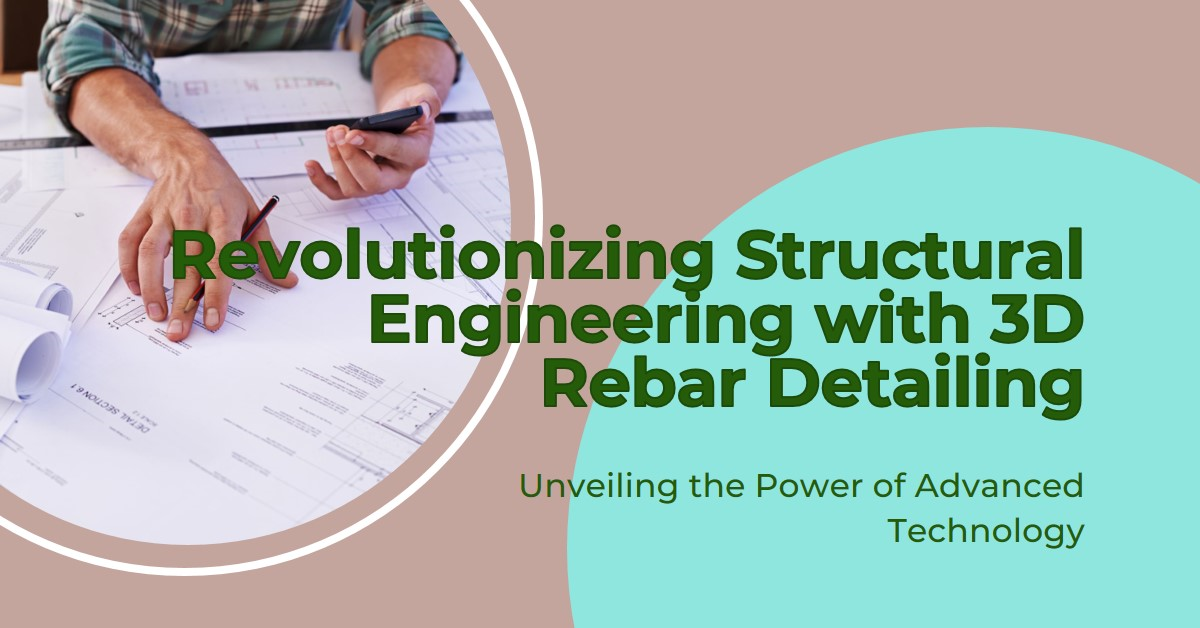In the dynamic realm of structural engineering, precision, and efficiency stand as pillars of paramount importance. In recent years, the advent of 3D rebar detailing has emerged as a game-changer, reshaping the landscape of construction projects. This advanced technology transcends traditional methods, bringing forth a new era of accuracy and streamlined processes.
Table of Contents
ToggleUnderstanding the Essence of 3D Rebar Detailing
In essence, 3D rebar detailing involves the creation of detailed three-dimensional models of reinforced steel structures, providing a comprehensive view of the entire construction. This method goes beyond the limitations of 2D drawings, offering a holistic representation that aids in visualizing the intricate details of reinforcement placement.
One of the primary advantages of 3D rebar detailing lies in its ability to detect clashes and conflicts in the design phase itself. By virtually constructing the entire structure, engineers can identify potential issues before they manifest in the physical realm. This proactive approach not only saves time but also minimizes the chances of errors during the construction process.
The Process Unveiled: From Concept to Concrete Reality
The journey of 3D rebar detailing commences with a meticulous examination of the structural design. Engineers input the design parameters into specialized software, generating a comprehensive 3D model. This model acts as a digital prototype, allowing for a nuanced exploration of the reinforcement layout.
Once the model is established, the software facilitates the automatic generation of detailed rebar drawings. These drawings include accurate dimensions, quantities, and placement instructions, serving as a crucial guide for construction teams. The seamless transition from the digital model to tangible construction plans enhances communication and collaboration between various stakeholders involved in the project.
Benefits Beyond the Surface: Efficiency, Precision, and Cost-Effectiveness
The adoption of 3D rebar detailing extends a multitude of benefits, significantly impacting the efficiency and precision of construction projects. Firstly, the detailed 3D models enable engineers to visualize the entire structure, promoting better decision-making and reducing the likelihood of design flaws.
Moreover, the precision achieved through 3D rebar detailing translates into tangible advantages during the construction phase. Accurate placement of reinforcement elements ensures structural integrity, enhancing durability and safety. Eliminating guesswork from the construction process minimizes the chances of rework, saving both time and resources.
From a financial standpoint, 3D rebar detailing proves to be a cost-effective solution in the long run. While the initial investment in specialized software and training may seem substantial, the return on investment becomes evident through reduced construction errors, increased project efficiency, and minimized material wastage.
Future Prospects: Navigating the Evolving Landscape of Structural Engineering
As technology continues to evolve, the prospects of 3D rebar detailing appear promising and expansive. The integration of artificial intelligence (AI) and machine learning into the software used for detailing holds the potential to further enhance the accuracy and efficiency of the process.
The collaboration between 3D rebar detailing and Building Information Modeling (BIM) is another avenue worth exploring. By seamlessly integrating these two technologies, construction professionals can harness a comprehensive digital representation of both the structural and non-structural elements, fostering a more holistic approach to project management.
In addition to technological advancements, the increasing emphasis on sustainable construction practices aligns seamlessly with the capabilities of 3D rebar detailing. The ability to optimize material usage and reduce waste contributes to the overall sustainability of construction projects, aligning with the global shift towards eco-friendly practices.
The Significance of 3D Rebar Detailing in Structural Design
Transitioning to 3D rebar detailing brings about a paradigm shift in structural design. The ability to visualize reinforcement elements in a three-dimensional space allows for a more precise understanding of their interaction with the overall structure. This newfound clarity is instrumental in optimizing the design for both efficiency and cost-effectiveness.
Additionally, the active voice of 3D rebar detailing empowers designers to quickly assess the impact of design modifications. By actively engaging with the model, they can visualize how changes affect the entire structure, enabling them to make informed decisions on the fly. This dynamic approach to structural design is a game-changer, ensuring that the final product aligns seamlessly with the envisioned architectural and engineering goals.
Navigating the Waters of Building Information Modeling (BIM)
Central to 3D rebar detailing is the utilization of Building Information Modeling (BIM), an intelligent 3D model-based process that provides insights for efficient planning, design, construction, and management of buildings and infrastructure. BIM acts as the digital backbone, integrating all aspects of a construction project into a unified platform.
The active integration of BIM in 3D rebar detailing facilitates a synchronized workflow where changes made in one aspect of the model automatically reflect in all related components. This real-time collaboration ensures that all stakeholders are working with the most up-to-date information, eliminating the risk of discrepancies that may arise in conventional 2D detailing methods.
Embracing the Future: Challenges and Considerations
While the future of 3D rebar detailing holds immense promise, it is not without its challenges. The learning curve associated with adopting new technologies can pose initial obstacles for construction professionals. Training programs and ongoing support become crucial elements in ensuring a smooth transition and optimal utilization of the technology.
Furthermore, the standardization of 3D rebar detailing practices across the industry is an ongoing effort. Establishing universal protocols and guidelines can enhance interoperability and facilitate seamless collaboration between various stakeholders. As the technology matures, industry-wide collaboration and knowledge-sharing will play pivotal roles in overcoming these challenges.
Reinforcement Detailing in the Third Dimension
Delving deeper into the intricacies of 3D rebar detailing, the focus shifts to reinforcement detailing. The active voice inherent in this method allows for a more granular examination of reinforcement elements, offering a detailed perspective on how each component contributes to the overall structural integrity.
Furthermore, 3D rebar detailing enhances accuracy by providing real-time clash detection. This proactive approach allows engineers to identify clashes between reinforcement elements and other structural components, reducing the likelihood of on-site conflicts and rework. The result is a construction process that is not only more efficient but also minimizes errors and delays.
Optimizing SEO: Key Phrases for 3D Rebar Detailing
For those delving into the world of 3D rebar detailing, understanding the key phrases associated with this technology is crucial for optimizing search engine visibility. Variants like “3D reinforcement detailing,” “BIM in construction engineering,” and “structural design with 3D modeling” are essential for attracting the right audience.
Active utilization of these key phrases throughout the content ensures that search engines recognize the relevance of the blog post to individuals seeking information on 3D rebar detailing. Strategic placement, without compromising readability, is the key to successful SEO optimization.
Conclusion: A Paradigm Shift in Structural Engineering
In conclusion, 3D rebar detailing represents a paradigm shift in the field of structural engineering. The precision, efficiency, and prospects associated with this technology position it as a cornerstone for the construction projects of tomorrow. Embracing 3D rebar detailing is not merely an adoption of a new tool but an investment in the longevity, safety, and sustainability of the structures we build.
As we navigate the evolving landscape of structural engineering, the integration of 3D rebar detailing becomes not just a choice but a necessity. The transformative impact on project timelines, costs, and overall quality is too substantial to overlook. The journey from concept to concrete reality has found a potent ally in the form of 3D rebar detailing, propelling the industry towards unprecedented heights of precision and efficiency.



